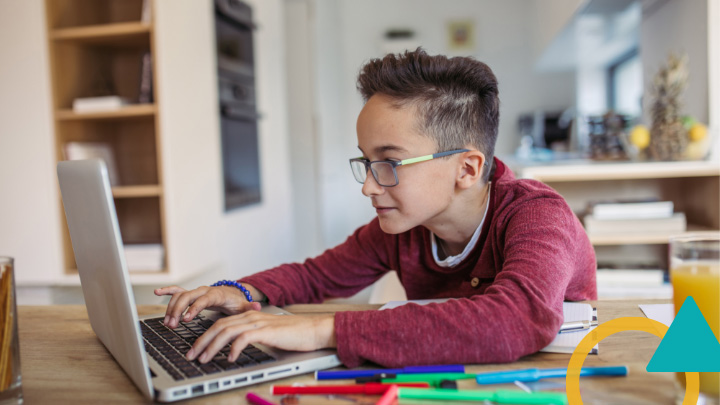With many schools starting the year either fully remotely or in a hybrid model, teachers are once again thinking outside the box of a traditional class period, and instead thinking in terms of two types of learning: synchronous and asynchronous time. Synchronous learning, of course, is any activity that teachers and students do at the same time, like small or whole group video calls. Asynchronous learning is any instructional task students do on their own, including practice problems, reading, exploratory activities, or projects.
Making synchronous learning engaging for students can be challenging. Students may be reluctant to turn their video on or less talkative than in a traditional classroom. As a BetterLesson instructional coach, I have worked with dozens of teachers since March to help them make their synchronous time more student-centered, so that students will attend, engage, and thrive.
One teacher I worked with this spring saw attendance at her weekly Monday check-ins drop off dramatically over the semester. We worked together to figure out how she could get her students back in the virtual room and how she could use collaborative groups, text discussion, and sharing work with peers to draw students in.
As a BetterLesson coach, I encourage teachers to put themselves in the shoes of students and think about what would make them engaged in synchronous learning. I urge teachers to explore engaging ways to start the class as students “enter” the room, give students a lot of time to interact with each other, and a way to end the class with a reflection.
Entering the Virtual Room
First, I recommend thinking about how students “enter the virtual room.” Many of the teachers I work with are highly concerned with how to build relationships with students remotely. In March, we had the advantage of knowing our students since the beginning of the year. This fall, building relationships will take a sustained, intentional effort. To build relationships and create a student-centered learning experience, teachers can:
- Establish daily check-ins to get to know your students and help them establish learning goals. A strategy like Connecting while Checking for Understanding or using emoji charts like this can help students to verbalize their emotions. If comfortable, students can share their check-in with a peer in a breakout room or with the whole class. Check this article for more ideas.
- Poll your students to provide engaging ways for students to share about themselves in a low-stakes manner. Tools like Mentimeter, Desmos, Zoom Polls, or PollEverywhere allow you to ask simple, fun to get-to-know-you questions. Using a poll can be a great task to have students do as you wait for the whole class to get on the video call.
Collaboration, Discussion, and Sharing Work
We all know that Zoom calls are not the best place for a whole group lecture. I work with teachers to design how to use synchronous time for what’s truly done best with a group: collaborative work, discussions, and sharing with their peers.
Small-Group Collaborative Work
One of the teachers I coach, Jessica (not her real name), is a middle school math teacher. Her typical routine was a mini-lesson followed by practice problems. In a traditional classroom, this worked for her because she was able to circulate in the room and work with a small group of students. However, in a virtual setting, students were checking out and not completing their work. We worked together to design how she could use synchronous time for more collaboration – and she saw student engagement dramatically increase. Teachers can:
- Encourage students to explore information together. Rather than do practice problems on their own, Jessica placed students into small groups to do their work collaboratively. In small groups, students can watch teacher-created screencasts, explore Sutori playlists, collaborate on a Google Doc, or read a text together. Consider using tools like GoFormative or Socrative to have groups submit finished work or have groups work using interactive Google Slides with Peardeck or Nearpod.
- Create and model group work “roles.” Jessica used student roles to help democratize the work and hold all students accountable. Consult the strategy Democratizing Group Work for more ideas.
- Use breakout rooms to create small group time. Zoom breakout rooms make small group work easy. However, you can also try hosting parallel Google Hangouts or getting creative about synchronous time. Jessica could pop into the breakout rooms and answer questions from students, while still giving them time to explore on their own.
Class Discussions
Another teacher I worked with, Paul (not his real name), missed his lively in-person class discussions and noticed there was too much student-teacher dialogue rather than student-student interaction in his virtual class. We worked together to create structures and routines for students to talk with each other more. To get the conversation flowing, teachers can:
- Set clear norms and expectations from the beginning and revisit them often. Many teachers have shared that students were often reluctant to have their video on or hesitant to talk aloud. Use the BetterLesson strategy Developing Norms for Productive Group Work for ways to set norms for synchronous distance learning.
- Display sentence starters by sharing your screen to show an anchor chart with sentence stems. Use the Accountable and Academic Student Talk Stems or Number Talk for more.
- Incentivise discourse. While we all want students to share their thinking for the sake of learning, sometimes offering small rewards can promote greater discourse. Paul displayed a Google Doc with students’ names and gave each student a “point” when they talked or asked a question. At the end of the class, the students with the most points chose a song to play while students completed their exit tickets. Consult the BetterLesson Strategy on Gamification or Implementing a Positive Reinforcement Economy.
Sharing or Presenting Student Work
Having the whole class or even a small group together is the perfect moment for students to share their learning with an authentic audience or get feedback from their peers. Both Jessica and Paul had Zoom “publication celebrations” where students shared a piece of work they had completed. Teachers can:
- Create opportunities for students to share their mastery with their peers, either in a breakout room or to the whole class. When students can clearly demonstrate what they learned, they often feel more confident and engaged in the material. Consider having students sign up when they’re ready to share with their class.
Ending the Virtual Class
Finally, I recommend a routine to end the class. A key component of student-centered learning is providing students space to reflect on their learning and their learning process. I worked with Jessica and Paul to create consistent routines at the end of their class that helped students reflect on their learning, such as:
- Make space for daily reflection on goals. In a synchronous setting, students then share their progress with their peers and celebrate their success. As students see their progress this can also lead to increased engagement. Consult the strategy Goal Setting and Reflection.
- Create time for groups to reflect on their learning together. In their small groups, students can reflect on their learning process and next steps. Group Work Reflection and Self Assessment.
Although there is so much on the plate of educators across the country right now, when we slow down and pause, we’re reminded of why we do this work. We care deeply about our students and strive to make our classrooms a place that supports student learning. While challenging, there are so many opportunities to make our distance learning as student-centered as possible. Embedding small groups and discussions into our synchronous learning will be key to finding our footing this fall.








